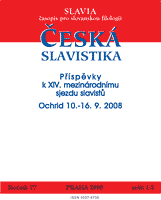Aplikace glottochronologie při klasifikaci balto-slovanských jazyků
The Application of Glottochronology in the Classification of Balto-Slavic Languages
Author(s): Petra Novotná, Václav BlažekSubject(s): Language studies
Published by: AV ČR - Akademie věd České republiky - Slovanský ústav and Euroslavica
Summary/Abstract: Summing up, it is possible to reconstruct the prehistory and early history of the Balto-Slavic dialect continuum in time as follows: 15/14th cent. BC – crystalization of the proto-Slavs in the southern periphery of the proto-Baltic continuum, localized from Silesia to Central Ukraine (Trziniec-Komarov culture). Let us compare the glottochronological estimates of the dates of divergence for some of the other Indo- -European branches: Indo-Iranian – 2000 BC (Starostin), Celtic – 1100 BC (Novotná – Blažek 2006). These results document that our conclusion supporting the Balto-Slavic unity is quite legitimate. 10/8th cent. BC – separation of the southwest Baltic dialect, the ancestor of Prussian, from the central Baltic dialect, the ancestor of Lithuanian and Latvian. The corresponding ancient communities differentiated in burial rites, namely the cremation vs. inhumation respectively. 200 AD – 5th cent. AD – coexistence of the Slavs and some East Germanic tribes (Goths?) in the territory from the upper Vistula and San to the middle Dniepr, i.e. including the probable Slavic homeland in the north and northeast of the Carpathian mountains. 6th cent. AD – Slavic expansion and first dialect differentiation between East Slavic (dialect of Antes) and the rest of Slavic. What was the first impuls for this disintegration? The migration and military activities of the Huns in Europe are probably too early (their power culminated in Europe in AD 375-453), on the other hand, the Avars came too late (568 is the date of their first conflict with the Byzantine Empire). Perhaps some of the East Germanic tribes, Goths or Gepids or both, occupying the territory between the Dniestr and the Carpathian Mountains, separated the Antes from other Slavs. 600 AD – separation of Latvian from the other central Baltic dialects, represented especially by Lithuanian. Regarding the phenomenon of Latvian palatalization, resembling the Slavic second palatalization, it is tempting to see here a specific Slavic influence, caused by the Slavic expansion, culminating in the 6th and 7th cent. Note: So called Pogańske gwary z Narewu probably represent a hybrid idiom based on the interference of Lithuanian & Latvian and Northeast Yiddish (Schmid 1986). From the point of view of Baltic dialectology, their identification with Yatwingian seems to be excluded.
Journal: Slavia - časopis pro slovanskou filologii
- Issue Year: LXXVII/2008
- Issue No: 1+3
- Page Range: 125-152
- Page Count: 28
- Language: Czech

